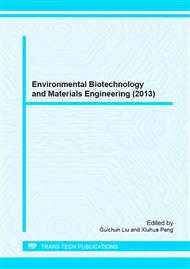[1]
J. G. Ferreira, J. H. Andersen, A. Borja, et al, Overview of eutrophication indicators to assess environmental status within the European Marine Strategy Framework Directive, J. Estuarine, Coastal and Shelf Science. 93 (2011) 117-131.
DOI: 10.1016/j.ecss.2011.03.014
Google Scholar
[2]
F.F. Wu, X. Wang, Eutrophication Evaluation Based on Set Pair Analysis of Baiyangdian Lake, North China, J. Procedia Environmental Sciences. 13 (2012) 1030-1036.
DOI: 10.1016/j.proenv.2012.01.096
Google Scholar
[3]
J.H. Andersen, C. Murray, H. Kaartokallio, et al, A simple method for confidence rating of eutrophication status classifications, J. Marine Pollution Bulletin. 60 (2010) 919-924.
DOI: 10.1016/j.marpolbul.2010.03.020
Google Scholar
[4]
P. Ekholm, J. Lehtoranta, Does control of soil erosion inhibit aquatic eutrophication. Journal of Environmental Management. 93 (2012) 140-146.
DOI: 10.1016/j.jenvman.2011.09.010
Google Scholar
[5]
A. Gudimov, S. Stremilov, M. Ramin, et al, Eutrophication risk assessment in Hamilton Harbour: System analysis and evaluation of nutrient loading scenarios, J. Journal of Great Lakes Research. 36 (2010) 520-539.
DOI: 10.1016/j.jglr.2010.04.001
Google Scholar
[6]
V. Lauringson, J. Kotta, P. Kersen, Use case of biomass-based benthic invertebrate index for brackish waters in connection to climate and eutrophication, J. Ecological Indicators. 12 (2012) 123-132.
DOI: 10.1016/j.ecolind.2011.04.009
Google Scholar
[7]
B.Q. Qin, Lake eutrophication: Control countermeasures and recycling exploitation, J. Ecological Engineering, 35 (2009) 1569-1573.
DOI: 10.1016/j.ecoleng.2009.04.003
Google Scholar
[8]
S.N. Levine, A. Lini, et al, The eutrophication of lake Champlain's northeastern arm: Insights from paleolimnological analyses, J. Journal of Great Lakes Research, 38 (2012) 35-48.
DOI: 10.1016/j.jglr.2011.07.007
Google Scholar
[9]
D. Styles, K.O. Brien, M.B. Jones, A quantitative integrated assessment of pollution prevention achieved by Integrated Pollution Prevention Control licensing, J. Environment International, 35 (2009) 1177-1187.
DOI: 10.1016/j.envint.2009.07.013
Google Scholar
[10]
Water and wastewater monitoring method, China Environmental Science Press, Beijing, (2002).
Google Scholar
[11]
M.F. Chislock, O. Sarnelle, L.M. Jernigan, et al, Do high concentrations of microcystin prevent Daphnia control of phytoplankton, J. Water Research, 47 (2013) 1961-(1970).
DOI: 10.1016/j.watres.2012.12.038
Google Scholar
[12]
M. Lürling, E. J. Faassen, Controlling toxic cyanobacteria: Effects of dredging and phosphorus-binding clay on cyanobacteria and microcystins, J. Water Research, 46 (2012) 1447-1459.
DOI: 10.1016/j.watres.2011.11.008
Google Scholar


